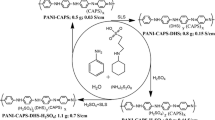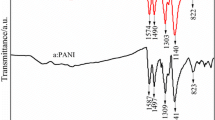Abstract
Synthesis of novel polyaniline salts is an important work for their use in industrial applications. The objective of this work is to use alcohol in the polymerization of aniline instead of hazardous protic acids, which are mostly being used. For this purpose, hyperbranched polyesters (HBPEs) containing many alcohol groups were selected. In the HBPEs, alcohol groups could be increased via preparation of first, second, and third generation of HBPE. HBPEs were synthesized from the reaction of 2,2-bis(hydroxymethyl)propionic acid (bis-MPA) and triethanolamine (TEA) as a nitrogen containing core. This reaction was promoted using polyaniline salt containing high-strength protic acid, trifluoromethanesulfonic acid, as catalyst for the first time. Interestingly, used these HBPEs in the aqueous polymerization of aniline to polyaniline salt containing HBPEs. Properties of these novel polyaniline salts in terms of yield, density, conductivity, solubility, crystalline nature, morphology, and application as electrode in supercapacitor were determined. These polyaniline salts containing dual dopants of H2SO4 and HBPE are stabile up to 210 °C and showed highly ordered semicrystalline nature with nanorods morphology (35 to 60 nm). Yield, density, and conductivity of the PANI-HBPEs salts are independent of the generation of HBPEs. Polyaniline salt containing third-generation hyperbranched polyester sample showed higher specific capacitance(450 F g−1). These polyaniline salts are insoluble in most of the common organic solvents. Polyaniline salts containing HBPEs in organic solvent were synthesized via emulsion polymerization pathway (E-PANI-HBPEs). These polyaniline salts contains three dopants, HBPE, dodecyl hydrogen sulfate (DHS) and H2SO4, were isolated in chloroform solvent, which showed particle size around 85 nm, with fluorescence property, and hydrophilicity. Polyaniline-HBPEs prepared via emulsion polymerization showed higher conductivity than that of the samples prepared via aqueous polymerization pathways.

Synthesis and properties of PANI-HBPE salts
















Similar content being viewed by others
References
Shirakawa H, Louis EJ, MacDiarmid AG, Chiang CK, Heeger AJ (1977) Synthesis of electrically conducting organic polymers: halogen derivatives of polyacetylene, (CH)x. J Chem Soc Chem Commun 16:578–580
Huang Y, Li J, Chen X, Wang X (2014) Applications of conjugated polymer based composites in waste water purification. RSC Adv 4:62160–62178
Dutta K, Das S, Rana D, Kundu PP (2015) Enhancements of catalyst distribution and functioning upon utilization of conducting polymers as supporting materials in DMFCs: a review. Polym Rev 55:1–56
Wang YZ, Epstein AJ (1999) Interface control of light-emitting devices based on pyridine-containing conjugated polymers. Acc Chem Res 32:217–224
Zhang W, Cheng Y, Yin X, Liu B (2011) Solid-state dye-sensitized solar cells with conjugated polymers as hole-transporting materials. Macromol Chem Phys 212:15–23
Elkais R, Gvozdenovic M, Jugovic BZ, Grgur BN (2013) The influence of thin benzoate-doped polyaniline coatings on corrosion protection of mild steel in different environments. Prog Org Coat 76:670–676
Wang K, Wu H, Meng Y, Wei Z (2014) Conducting polymer nanowire arrays for high performance supercapacitors. Small 10:14–31
Mirfakhrai T, Madden JDW, Baughman RH (2007) Polymer artificial muscles. Mater Today 10:30–38
Novak P, Muller K, Santhanam VSK, Haas O (1997) Electrochemically active polymers for rechargeable batteries. Chem Rev 97:207–282
Dutta K, Kumar P, Das S, Kundu PP (2014) Utilization of conducting polymers in fabricating polymer electrolyte membranes for application in direct methanol fuel cells. Polym Rev 54:1–32
Nataraj MSK, Tejraj M, Aminabhavi, Sukumar R, Madhusoodana CD (2006) Polyaniline membranes for separation and purification of gases, liquids, and electrolyte solutions. Sep Purif Rev 35:249–283
Song E, Choi JW (2013) Conducting polyaniline nanowire and its applications in chemiresistive sensing. Nanomaterials 3:498–523
Kelly FM, Meunier L, Cochrane C, Koncar V (2013) Polyaniline: application as solid state electrochromic in a flexible textile. Displays 34:1–7
Gordana CM (2013) Recent advances in polyaniline research: polymerisation mechanisms, structural aspects, properties and applications. Synth Met 177:1–47
Peng D, Zhi L, Zhenzhen C, Jiao Z, Chao W, Xinhua X (2016) Rapid synthesis of hierarchical nanostructured polyaniline hydrogel for high power density energy storage application and three-dimensional multilayers printing. J Mater Sci 51:4274–4282
Guo F, Liu Q, Hongyu M (2016) Flexible and cross-linked polyaniline nets as promising supercapacitor electrodes. Mater Lett 163:115–117
Apparao T, Arukula R, Narayan R, Rao CRK, Raju KVSN (2015) Energy storage and surface protection properties of dianiline co-polymers. RSC Adv 5:106523–106535
Ravi B, Rajender B, Palaniappan S (2016) Improving the electrochemical performance by sulfonation of polyaniline-graphene-silica composite for high performance supercapacitor. Int J Polym Mater 65:835–840
Park YR, Doh JH, Shin K, Seo YS, Kim YS, Kim SY, Choi WK, Hong YJ (2015) Solution-processed quantum dot light-emitting diodes with PANI: PSS hole-transport interlayers. Org Electron 19:131–139
Kulkarni MV, Kasiviswanath A, Khanna PK (2006) Synthesis and characterization of conducting polyaniline doped with polymeric acids. J Macromol Sci Pure Appl Chem 43:759–771
Ramesh G, Palaniappan S (2015) A novel process of alcohol promoted polymerization of aniline to form a nanofibrous, fluorescent and highly crystalline polyaniline salt. New J Chem 39:8545–8551
Gao C, Yan D (2004) Hyperbranched polymers: from synthesis to applications. Prog Polym Sci 29:183–275
Flory PJ (1952) Molecular size distribution in three dimensional polymers. VI. Branched polymers containing A—R—Bf-1 type units. J Am Chem Soc 74:2718–2723
Flory PJ (1953) Principles of polymer chemistry. Cornell University Press, Ithaca
Hsieh TT, Tiu C, Simon GP (2001) Melt rheology of aliphatic hyperbranched polyesters with various molecular weights. Polymer 42:1931–1939
Ikladious NE, Mansour SH, Rozik NN, Dirnberger K, Eisenbach CD (2008) New aliphatic hyperbranched polyester polyols based on 1,3,5-tris(2-hydroxyethyl) cyanuric acid as a core. J Polym Sci A: Polym Chem 46:5568–5579
Jena KK, Raju KVSN, Prathab B, Aminabhavi TM (2007) Hyperbranched polyesters: synthesis, characterization, and molecular simulations. J Phys Chem B 111:8801–8811
Malmstrom E, Johansson M, Hult A (1995) Hyperbranched aliphatic polyesters. Macromolecules 28:1698–1703
Magnusson H, Malmstrom E, Hult A (2000) Structure buildup in hyperbranched polymers from 2,2-Bis(hydroxymethyl)propionicAcid. Macromolecules 33:3099–3104
Goswami A, Singh AK (2004) Hyperbranched polyester having nitrogen core: synthesis and applications as metal ion extractant. React Funct Polym 61:255–263
Palaniappan S, Rajender B (2010) A novel polyaniline-silver nitrate-p-toluenesulfonic acid salt as recyclable catalyst in the stereoselective synthesis of β-amino ketones: “one- pot” synthesis in water medium. Adv Synth Catal 352:2507–2514
Hansen AS, Du L, Kjaergaard HJ (2014) The effect of fluorine substitution in alcohol–amine complexes. Phys Chem Chem Phys 16:22882–22891
Meixiang W (1989) The influence of polymerization method and temperature on the absorption spectra and morphology of polyaniline. Synth Met 31:51–59
Xia Y, Wiesinger JM, Macdiarmid AG, Arthur JE (1995) Camphorsulfonic acid fully doped polyaniline emeraldine salt: conformations in different solvents studied by an ultraviolet/visible/near-infrared spectroscopic method. Chem Mater 7:443–445
Panel ML, Fangle Z, Dazhang Z, Hui D, Yaokang L, Liangchun L, Lihua G (2018) Ultramicroporous carbon nanoparticles derived from metal–organic framework nanoparticles for high-performance supercapacitor. Mater Chem Phys 211:234–241
Panel LM, Dazhang Z, Yunhui Z, Mingxian L, Hui D, Wei X, Quanjing Z, Liangchun L, Yaokang L, Lihua G (2017) Design of carbon materials with ultramicro-, supermicro- and mesopores using solvent- and self-template strategy for supercapacitors. Micropor Mesopor Mater 253:1–9
Panel MXL, Ling YC, Dazhang Z, Hui D, Wei X, Zijie X, Lihua G, Long WC (2016) Zinc tartrate oriented hydrothermal synthesis of microporous carbons for high performance supercapacitor electrodes. Chin Chem Lett 27:399–404
Rahul RS, Christine Y, Jing T, Toshiaki T, Yusuke I, Naoya K, Yusuke Y (2016) A high-performance supercapacitor cell based on ZIF-8-derived nanoporous carbon using an organic electrolyte. Chem Commun 52:4764–4767
Rahul RS, Shao HH, Kevin CWW, Yusuke Y (2014) Large-scale synthesis of reduced graphene oxides with uniformly coated polyaniline for supercapacitor applications. Chem Sus Chem 7:1551–1556
Jing T, Yusuke Y (2016) Carbon materials: MOF morphologies in control. Nat Chem 8:638
Huihua L, Juan S, Linlin W, Xiaomiao F, Ruiqing L, Wenjin Z, Zhendong H, Yanwen M, Lianhui W (2017) Flexible all-solid-state supercapacitors based on polyaniline orderly nanotubes array. Nanoscale 9:193–200
Xiaomiao F, Ningna C, Jinhua Z, Yi L, Zhendong H, Lei Z, Yanwen M, Lianhui W, Xiaohong Y (2015) Facile synthesis of shape-controlled graphene–polyaniline composites for high performance supercapacitor electrode materials. New J Chem 39:2261–2268
Xiaomiao F, Jinhua Z, Linlin W, Yi L, Zhendong H, Shufen C, Yanwen M, Lianhui W, Xiaohong Y (2015) Synthesis of shape-controlled NiO–graphene nanocomposites with enhanced supercapacitive properties. New J Chem 39:4026–4034
Umashankar M, Palaniappan S (2015) Improved electrochemical performances of polyaniline by graphitized mesoporus carbon: hybrid electrode for supercapacitor. J Appl Polym Sci 132:42540
Rizwan U, Salma B, Anwarul HAS, Khurshid A, Fadi A (2016) Synthesis and characterization of polyaniline doped with polyvinyl alcohol by inverse emulsion polymerization. Synth Met 222:162–169
Acknowledgements
We thank to CSIR, New Delhi under the TAPSUN program (NWP-0056) for funding. We are thankful to Dr.S.Chandrasekhar, Director, and Dr.T.Shekharam, Head, PFM Division,CSIR-IICT for their support and encouragement.SNK thanks UGC, India, for financial Support.
Author information
Authors and Affiliations
Corresponding author
Rights and permissions
About this article
Cite this article
Karri, S.N., Male, U. & Srinivasan, P. Polyaniline salt catalyzed synthesis of hyperbranched polyester and its use as dopant in polyaniline salt for coating, fluorescence, and supercapacitor electrode. Ionics 25, 191–202 (2019). https://doi.org/10.1007/s11581-018-2583-6
Received:
Revised:
Accepted:
Published:
Issue Date:
DOI: https://doi.org/10.1007/s11581-018-2583-6




